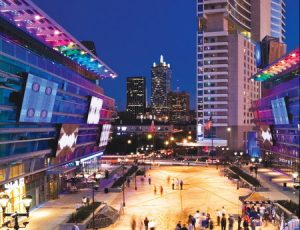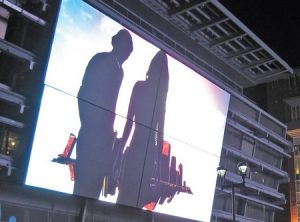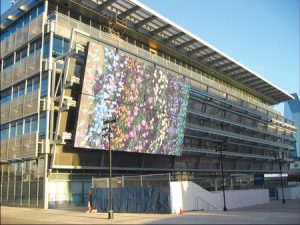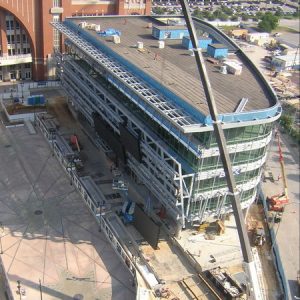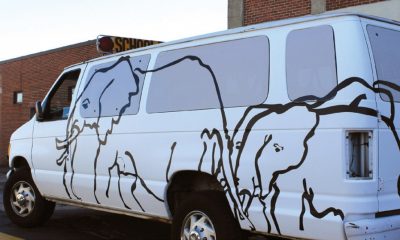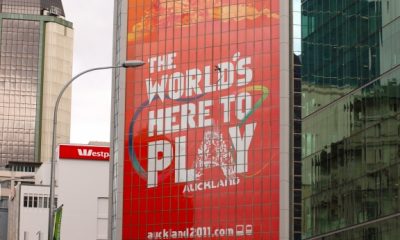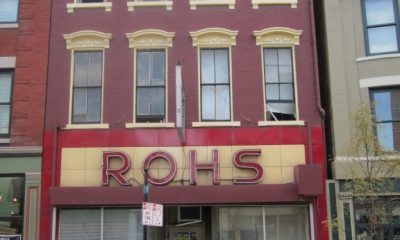Uncategorized
Victory Park: Deep in the Heat of Dallas
EDS displays make a big statement in this entertainment destination.
Published
17 years agoon
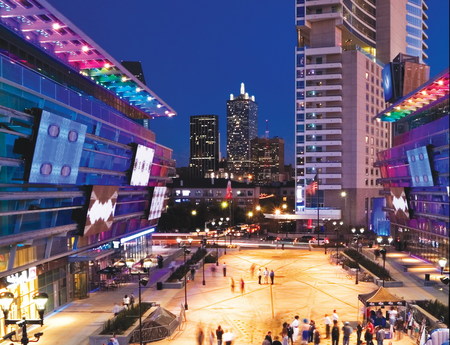
Texas always does things in big ways, and Victory Park, an urban, mixed-use community/business-development area that recently opened in Dallas, personifies that grandiose Texan vision.
The project kicked off in 2001 with the opening of the American Airlines Center. The site’s 72 acres comprise upscale housing, Class-A office space, premium retail tenants, and distinctive dining destinations, night clubs and sport bars. Commissioned by Hillwood, a Perot® company (Ft. Worth, TX), and designed by such noted architects as Orne + Assoc. (Los Angeles), Kohn Pederson Fox (New York City, London and Shanghai offices), Philippe Starck (Paris) and HKS Architects (Dallas), Victory Park’s master plan envisioned the project would solidify the Dallas metropolitan area’s image as a destination/entertainment district.
A network of grand-format LED displays, a key component of this entertainment destination, intricately connects visitors to the United States’ largest outdoor, digital-art gallery (part of what is known as Victory Media Network® [VMN]) and binds Victory Park tenants, visitors, sponsors and visual artists into a globally connected media world.
Kristin Gray, Victory Media Network’s® (VMN) director, said, “VMN has a considerable social and commercial significance for its community, because it integrates sponsor branding and advertising messages, video art, Victory Park onsite-event promotions and public-service announcements into a unifying, audiovisual network on a daily basis to Victory Park visitors, tentants and residents.”
Victory Park’s EDS components include two display systems, a street-level, electronic-kiosk network and an outdoor media system that comprises 11 Barco (headquartered in Kortrijk, Belgium) LED screens that were deployed around specific areas of Victory Park Plaza.
The high-resolution Barco OLite 510 outdoor LED module was selected for the LED-display network, because it was the only, 10mm, SMD-LED format available at the time and offered excellent viewing angles, which produce high resolution at a short distance.
AdvertisementThis display configuration and its accompanying horizontal, screen-movement system forms one of the world’s first, and largest, mobile-media facades.
VMN is born
Three distinct, yet integrated, display sites comprise the VMN display system, the site’s most visible aspect:
• The Portal Screen. The 19 x 32-ft., 10-pixel-pitch Barco OLite board faces North Houston and Oliver streets, the site’s busiest intersection. It attracts and promotes plaza activity and incor¬porates event promotions, sponsor branding, Victory Park advertising, and daily, live WFAA (an ABC-affiliate) newscasts.
• The Tower Display. Victory Park’s voice and beacon. Two, 20-ft.-square, 10-pixel-pitch OLite Barco boards form a diagonal. One screen faces Victory Park’s main gateway, and the other faces the plaza. The tower displays Victory Park and sponsor logos.
Advertisement• Media Walls. Eight, 10-pixel-pitch OLite Barco boards, each 15 x 26 ft. long, are divided into two sets of four, mobile displays. When the screens on each media wall are positioned together, they display a single, 31 x 53-ft. image. Each set is mounted on a five-story office building to create the site’s epicenter. Both buildings face each other, separated by the large plaza’s courtyard. This allows visi¬tors unobstructed views and immersive experiences with the ongoing media-wall presentations.
Horizontal rails allow the videoscreens to move across each building. The mobile screens create various aspect ratios (four screens together or two screens apart with two screens together, etc.) that enhance the displays’ choreog¬raphy and content variety. The walls showcase what is reportedly the world’s largest, outdoor, digital-art gallery of videos, films and ongoing sponsorship messages that change daily. An immersive sound system accompanies the show.
Perched atop each plaza building, a supporting, horizontal truss system overhangs an LED lighting system, which augments the media walls’ video content. Affectionally known as the “Eyebrow,” the overhead lighting display comprises three, independent illumination setups. The first two, LED light systems were designed by Illumivision. The first illuminates an architectural mesh that delineates the Media Walls from the building structure. The second setup lights the “Eyebrow.” The final lighting arrangement illuminates the general Plaza area.
Before this project began, Hillwood representatives had seen another LED media project, Las Vegas’ Fashion Show Mall (see ST, February 2003, page 78), which incorporates large, mobile Barco LED video displays that also move on a horizontal rail system. They asked Fashion Show’s key creators to create a similar, outdoor display for Victory Park.
Hillwood first hired a contract-management firm, Sensory Interactive (Baltimore), whose principal, Randy Byrd, oversaw Fashion Show’s development and startup. Byrd’s company was involved in Victory Park’s design, construction and operational setup. Byrd oversaw the implementation of the VMN Barco screens’ construction (see sidebar on this page). In its two-and-a-half-year project involvement, Byrd said his company acted as the owner’s representative in creating a media platform that blends visual and lighting technologies with the project’s architecture.
From signs to media platforms
AdvertisementDavid Gales, principal of Vantage Technology Consulting Group (Manhattan Beach, CA, and Cambridge, MA), helps businesses integrate new technologies. Vantage helped transform Victory Park’s EDS system into a series of outdoor media platforms integrated into public space. The company was also responsible for the technology systems’ engineering, infrastructure, design and project management.
Gales said, “The challenge was how digital media could create an exciting urban destination and a dynamic, mixed-use environment, and also be economically sustainable. This led us to the unified structure that we called VMN, which presents a mix of commercial and non-commercial content in a large, public space.”
Hillwood sought potential revenue streams for VMN, which were defined as corporate sponsorships. Hillwood then mapped out a plan to secure them and set up an organizational structure to get, and manage, that content and its supporting technical operations.
Because this structure hadn’t been built before, the teams involved – San Francisco-based Foghorn Creative (content management), New York City-based Show & Tell (show control and content processing), Sensory Interactive (development and project management) and Hillwood – invented VPN as its own entity: “a private media network of digital displays and communication systems [electronic kiosks], melded into the architecture of Victory Park in a spectacular way,” according to Gales.
To build a revenue stream and ROI into VMN, Gray said commercial-videoscreen accessibility was transformed into an exclusive sponsorship buy-in, which allowed sponsors access to all 11 LED displays and the electronic kiosks. “Single-category” control guarantees VMN sponsorship exclusivity. For example, only one bank, one mass merchandiser and one airline, etc., could become sponsors. Currently, three sponsors – Target, Bank of America and Lexus – have signed.
You’ve got soul
If Victory Park’s heart is its architecture and EDS integration, its soul lies within VMN and its media walls. The walls’ noncommercial, digital-art program serves as an ongoing cultural area that rein¬forces Victory Park and Dallas as a new, international entertainment destination.
Operating at least 16 hours daily, the media walls offer various content:
• An outdoor art gallery. The media walls comprise the United States’ largest outdoor digital-art gallery. In conjunction with VMN, the Victory Arts program collects graphic animations and video art for continual display on the media walls.
• Commissioned art. Jennifer Steinkamp, an internationally known installation artist who works with architecture, motion and perception, created “Ring of Fire” for VMN.
• A unique branding opportunity. Sponsorships allow corporations exclusive branding rights to promote their business actvities and host special events. Each sponsorship opportunity allows corporations specific time each day on VMN’s media walls, the tower screen, the portal screens and the electronic-kiosk system.
• Live news on a daily basis. One tenant, WFAA-TV (an ABC affiliate), airs news and entertainment to the greater Dallas metropolitan area. To complement VMN, WFAA broadcasts its live news segment at selected times on the portal screen.
At least 40 to 60% of the media walls’ daily content features the digital-art collection. Foghorn Creative’s executive producer, Fritha Knudsen, curated the collection, which entailed soliciting, collecting, organizing and programming the video art.
Foghorn established a worldwide call for entries to acquire a comprehensive video collection. Videographers, digital artists and graphic animators entered such categories as Digital Art, Visual Storytelling, Animation and (very) Short Films.
More than 500 video submissions were reviewed and categorized as either acceptable for judging or to be returned to the artist. Winning videos were organized into various themed categories and processed to fit a specific screen’s aspect ratios and video file format(s).
Knudsen said, “The Media Walls have become a cultural enabler for Dallas in putting it in an international spotlight as the leading provider of a major outdoor digital and video art gallery.”
The new face of signage
Victory Park’s videoscreens combine various LED screen formats – from electronic signage to media displays – into a singular network, in which form (the LED videoscreens) is driven by function (art and sponsor¬ship messages). Why is this, and how can it be so popular?
Ubiquitous computing – home computing, office work, home entertainment, cellphones, laptops, etc. – has groomed visually literate people who are more receptive to public electronic displays.
Gales said, “A new public-media paradigm is being created and, in some ways, still being defined. Whatever it will become, Victory Park is not intended to become another Times Square. Culture and art, rather than advertising, is the driving force its content engine.”
What began as a collection of media elements has been carefully crafted into an immersive, multimedia environment that redefines Dallas and the entertainment, space and digital art presented in this public space.
Show Control
Show & Tell Productions Inc. (New York City), which initially served as a creative technology consultant to the Victory Park project, also contributed to the development of the content management and show-control software systems; the modeling of content operations; the definition of the VMN content specifications; and ongoing VMN content processing.
Warren Levy, Show & Tell’s vice president of new business development, said the process spanned approximately a year from contract signing to final client acceptance of all the software systems.
According to Levy, Show & Tell first investigated the client-specific requirements. “Overall, we considered what kinds of media content Victory Park was going to play on which of their 11 LED videoscreens and at what times.”
The system would ultimately incorporate:
• The aspect ratios of the tower’s, the portal’s and the Media Walls’ LED videoscreens.
• The ongoing movement of both Media Walls.
• The image configurations on the moving Media Walls.
• The audio that accompanies the Media Walls and Portal.
• The overhead lighting displays emanating from the “Eyebrows.”
• Media-content distribution to the electronic kiosks.
• A web-based interface for scheduling shows.
• A live interface for executing custom shows for special events.
• Multiple security levels for scheduling and system administration.
A centralized control system manages the various VMN media sites and also coordinates pre-recorded content (artist-created, sponsorship promos and VMN-branded content) with live-event presentations (WFAA daily news reports).
Levy said Show & Tell wrote the functional requirements and technical specifications of the VMN show-control and content-management systems; developed the applications; then installed, configured and tested the systems onsite. Final delivery included comprehensive documentation and training for Victory Park staff.
Here’s how the various software system components mesh:
• The show-control system controls video-playback and routing devices in conjunction with the videoscreen-movement, the audio and the lighting systems. The show-control system executes the daily schedule, and it provides an interface for building synchronous live shows that incorporate all system aspects during special events.
• The content-management and scheduling-system software schedule and choreograph video files that play on the videoscreens, screen-movement profiles that move the screens, audio files and lighting cues. The software graphically represents video, audio, lighting and motion systems’ synchronization to simplify meeting each show’s requirements.
• A reporting interface generates run-logs of media files played during the day. It also creates user-defined reports for tracking system errors, the current show-control system status, past and future schedules, and video- and audio-asset availability.
• A remote-control system comprises tablet PCs that can be moved into the pedestrian courtyard between the media walls. This gives the VMN staff wireless access to the show-control system’s peripheral devices from one user interface.
• A central SQL database serves as a central repository for data for the show-control system, the content-management and scheduling system, and the reporting interface. The data consolidation integrates disparate components into a single, cohesive system.
• Content processing and transformation of audio and video source files conform them to VMN rules. Each media file is reviewed to determine what services must be performed — converting video-art submissions, sponsors’ messages and Victory Park branding materials into fully compatible formats for the 11 LED videoscreens and the digital kiosks. Other tasks include ensuring all files conform to the run-times for the program blocks managed by the scheduling system, adding credits to artist submissions (as necessary) and entering a record in the content-management system for each content piece.
The company will continue to provide Victory Media Network with content processing.
Show & Tell’s show-control-system completion and operation has turned the VMN into a unified entertainment destination. Disparate media content has been transformed into a seamless experience that’s available 16 hours daily. All that’s left is for people to check it out – and they do, every day
Louis M. Brill is a journalist and consultant for high-tech entertainment and media communications. He can be reached at (415) 664-0694 or louisbrill@sbcglobal.net

SPONSORED VIDEO
Introducing the Sign Industry Podcast
The Sign Industry Podcast is a platform for every sign person out there — from the old-timers who bent neon and hand-lettered boats to those venturing into new technologies — we want to get their stories out for everyone to hear. Come join us and listen to stories, learn tricks or techniques, and get insights of what’s to come. We are the world’s second oldest profession. The folks who started the world’s oldest profession needed a sign.
You may like

ISA Announces New Tradeshows and Meetings VP

5 Reasons to Sell a Sign Company Plus 6 Options

Sign Products Wrap-Up for April
Subscribe

Bulletins
Get the most important news and business ideas from Signs of the Times magazine's news bulletin.
Most Popular
-

 Tip Sheet1 week ago
Tip Sheet1 week agoAlways Brand Yourself and Wear Fewer Hats — Two of April’s Sign Tips
-

 Ask Signs of the Times2 days ago
Ask Signs of the Times2 days agoWhy Are Signs from Canva so Overloaded and Similar?
-

 Real Deal1 week ago
Real Deal1 week agoA Woman Sign Company Owner Confronts a Sexist Wholesaler
-

 Benchmarks5 days ago
Benchmarks5 days ago6 Sports Venue Signs Deserving a Standing Ovation
-

 Editor's Note2 weeks ago
Editor's Note2 weeks agoWhy We Still Need the Women in Signs Award
-

 Women in Signs1 week ago
Women in Signs1 week ago2024 Women in Signs: Megan Bradley
-

 Photo Gallery7 days ago
Photo Gallery7 days ago21 Larry Albright Plasma Globes, Crackle Tubes and More
-

 Women in Signs1 week ago
Women in Signs1 week ago2024 Women in Signs: Ashley Borell
